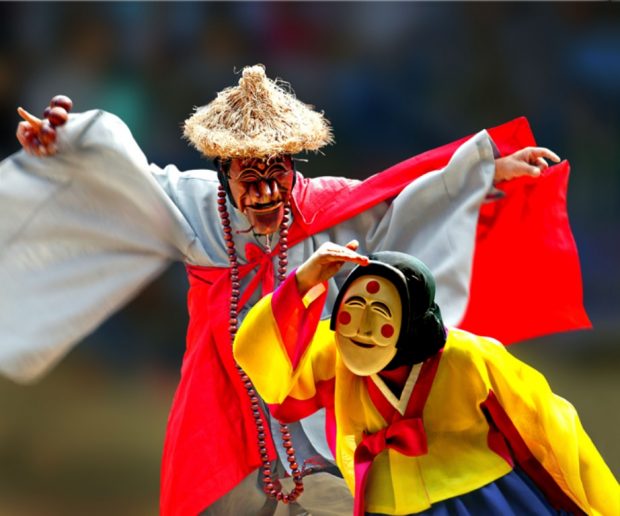
Exploring the Andong Mask Festival
Mask dance is an elusive aspect of Korean culture. Many visitors to the peninsula are vaguely aware of it; they may have seen a yangban mask printed on a bus, or noticed the iconic character faces that line Yaksu Station. But in a country whose nation-brand is largely connected to technology, K-Pop and ballistic missile-wielding neighbors, the delicate theatrics of mask dance struggle to leave an impression in the minds of tourists. Modern people are often more familiar with Myeongdong’s skincare masks than they are the smiling yangban or pune. But since 1997, the Andong Mask Festival has worked to promote this ancient art around the world. In an interview, director of management Kim Juho said: “The mask dance festival is very popular domestically, but not in the rest of the world. When you think of Italy, you think of the Venice Carnival. If you think of Brazil, you think of Carnival. But very few people associate mask dance with Korea, and we want to change that. We want to make this event a worldwide one, and we want foreigners to imagine mask dance when they think of Korea’s culture.”
The festival is held for 10 days each October. Last year, it welcomed over 1.2 million visitors, with attendance records showing a steady increase in popularity. In addition to promoting domestic arts, the event also features folk dance performances by international troupes. Thailand was given the spotlight this year to commemorate the 60th anniversary of diplomatic relations between the Southeast Asian nation and South Korea. The 2018 festival mascot is a conjoined Korean and Thai dance mask named Janus, after the Roman god of time, gates and beginnings. “In 2017,” Kim said, “Turkey was the co-host. Each year, we choose a different country as a co-host. Usually it’s to commemorate an important historical event.”
In addition to housing the festival grounds, Andong city is also home to the Hahoe Folk Village, which was registered as a UNESCO Heritage Site in 2010. Here, traditional craft masters make the masks, which can be purchased at tent stalls near the festival’s main stage. A local tourism brochure explains: “While most traditional masks are made of paper or gourd, Hahoe masks are made of alder wood and are wonderfully carved in various expressions.” This is reflective of Korean mask dance’s region-locked nature. Depending on what province the dance originates from, costuming, plot and vocal expressions vary. Performances were heavily influenced by regional politics during the Goryeo and Joseon dynasties. Historically, mask dance served as a way for commoners to vent their frustrations with the ruling aristocracy. All of the most iconic masks are essentially stock characters ― the smiling aristocrat, a beleaguered butcher, a stone-faced bride whose mask suggests faint anxiety. As Judy Van Zile writes in her 2003 book, Perspectives on Korean Dance, the form “allowed the people of former times the opportunity to poke fun at things they would normally not discuss in public: liberties taken by ostensibly serious, wholesome monks; frivolous rompings of upper-class noblemen; and bawdy activities of matchmakers.” She recounts that the practice was allowed in the royal court during the Goryeo Dynasty, but banned during Joseon, likely due to the rising influence of conservative Confucian thought.
Mask dance instead thrived in the public square, where disguised faces allowed performers to criticize corruption and the hyperindulgent lifestyles of the wealthy. Socioeconomic elites were less enthusiastic about the art. In fact, a police crackdown on “treasonous” theater serves as the inciting incident in The King and the Clown, a 2005 film that solidifies the reputation of Korean film worldwide. These political themes make mask dance relevant even today. While milling about the festival grounds, it’s easy to spot the occasional participant in a Guy Fawkes mask, which became associated with the hacker collective Anonymous and government transparency in the mid-2000s. Kim Juho commented on the art’s modern relevance: “Even contemporary heroes like Batman and Spiderman wear masks. That is important. You might be timid or quiet in everyday life, but with a disguise, there are no restrictions. Everyone is equal with a mask on. There is no social hierarchy, and it’s near-impossible to distinguish someone’s age. You’re happier. You’re more free. That’s why mask dance has lasted for hundreds of years.”
By Rachel Stine
(Korea Times)



